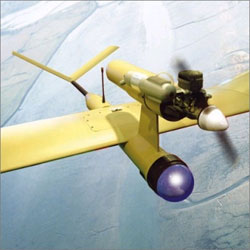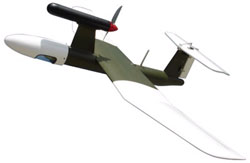Pakistan develops impressive UAV capabilities
02 Dec 2008
Pakistan has developed an impressive capability to design and build drones or unmanned aerial vehicles (UAVs), some of which are being used to spy on al Qaeda and Taliban militants and listen in on their phone calls. The Pakistan Air Force (PAF) currently fields two UAV squadrons and has plans to boost the number up to six.
 In addition to the Bravo+ UAV, which, according to PAF chief Air Chief Marshal Tanvir Mahmood Ahmed, has been built indigenously, the air force will also receive the Falco UAV produced by SelexGalileo of Italy. The two systems will be used mainly for aerial reconnaissance and information gathering, although the PAF will later also induct UAVs equipped with weapon systems to carry out offensive operations.
In addition to the Bravo+ UAV, which, according to PAF chief Air Chief Marshal Tanvir Mahmood Ahmed, has been built indigenously, the air force will also receive the Falco UAV produced by SelexGalileo of Italy. The two systems will be used mainly for aerial reconnaissance and information gathering, although the PAF will later also induct UAVs equipped with weapon systems to carry out offensive operations.
"This capability we are developing fairly rapidly; we are becoming mature. It is part of our operations now and I look forward to seeing this in real operations by [the] beginning [of] 2009," said ACM Tanvir Ahmed.
Meanwhile, Pakistani sources said that in the current war against terror al-Qaida and Taliban fighters not only use mobile and satellite phones for communication, but also sophisticated military radios. This has led to the development of SIGINT [signals intelligence] capabilities for small drones and robotic blimps by companies like EastWest Infiniti aimed at capturing such conversations.
These systems are designed for militaries unable to afford high-end, dedicated SIGINT platforms. EastWest's Whisper Watch system can detect and monitor electronic emissions up to 250 kilometers away which it then retransmits to a ground station.
Karachi-based Integrated Dynamics (ID) has received export orders for its Border Eagle surveillance drone from the United States Homeland Border Control for border patrol duties. Some 20 of these mini surveillance systems are to be delivered before the end of February.
On-board sensors are to be supplied in the US.
Although Pakistan is ID's biggest customer for UAVs and support systems, its expertise in flight control, tele-command and control systems has won recognition in several other countries including France and the UK to which such electronic equipment has been supplied.
While the company's smaller UAVs are powered by piston engines in the pusher configuration, the Tornado 2000 aerial target and decoy system, also on display, is powered by two 18-pound thrust mini turbojets, which endow a speed range of 70 to 300 knots. These Tornado's can emit false radar signals to confuse enemy air defenses into thinking they are attacking aircraft.
 To help train UAV operators, ID has also developed pilot and mission simulators that offer low cost solutions to training requirements that would otherwise oblige use of real UAVs.
To help train UAV operators, ID has also developed pilot and mission simulators that offer low cost solutions to training requirements that would otherwise oblige use of real UAVs.
The pilot simulator provides a high level of realism and can support single or multiple instrument failures, while the mission simulator enables the user to analyze the mission before the actual flight, thus reducing risk and increasing system cost effectiveness.
Such indigenously built gear was on display at IDEAS 2008, Pakistan's military trade show held at Karachi.






















